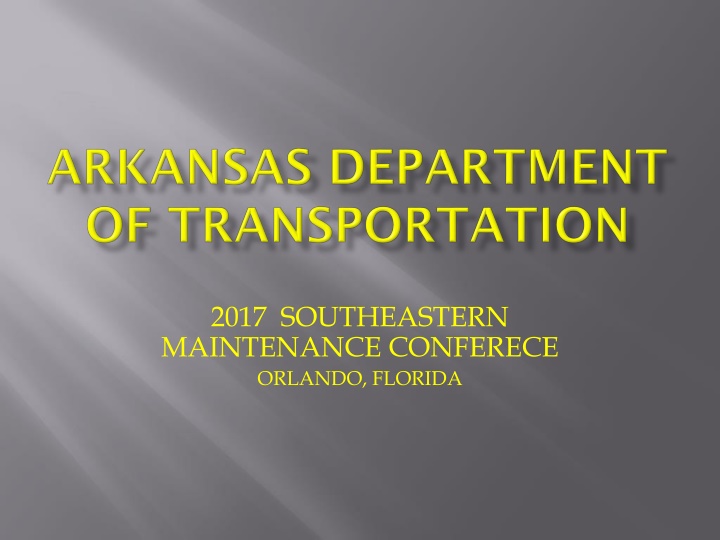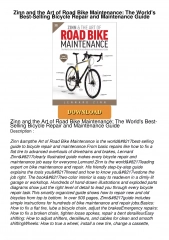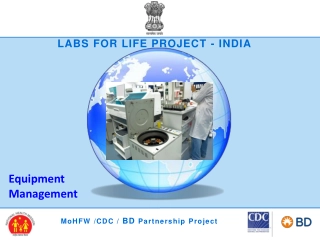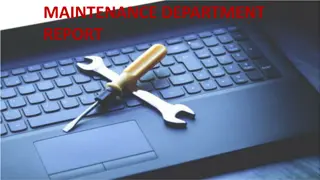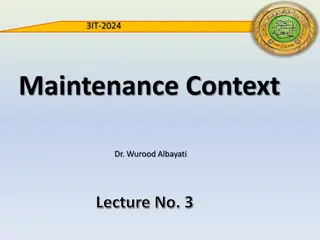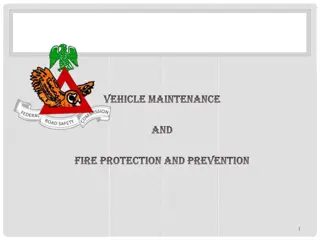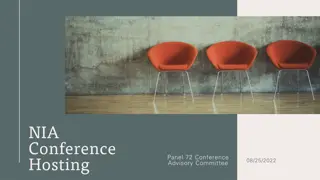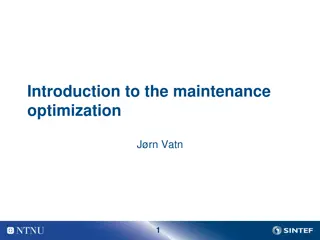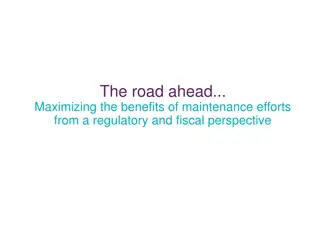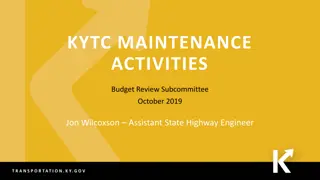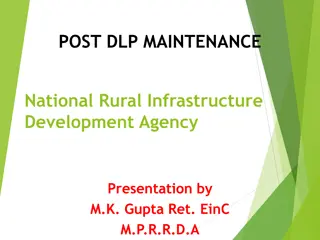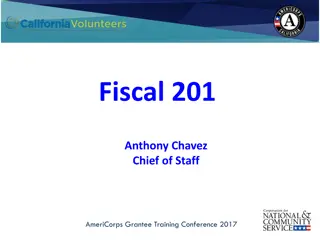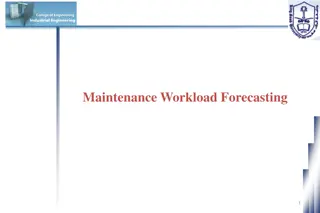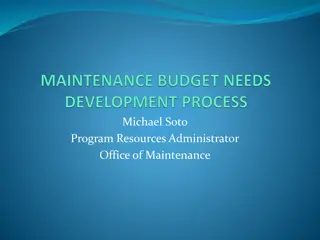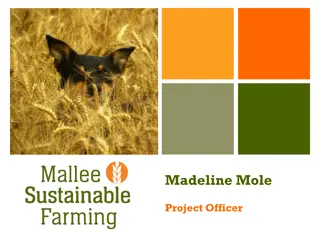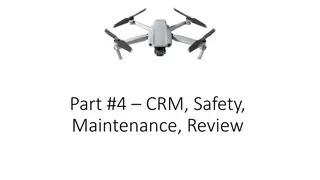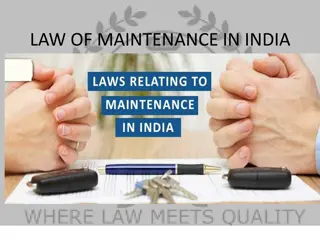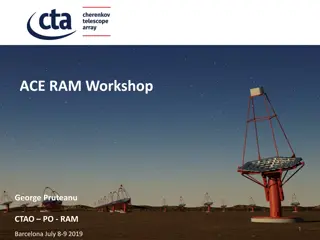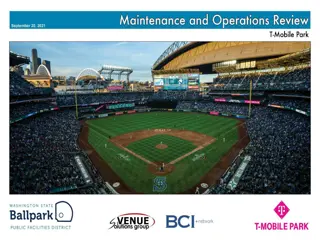Southeastern Maintenance Conference 2017 Review
Review of current practices and policies for pavement markings, raised pavement markers, and high-performance pavement markings (HPPM) at the 2017 Southeastern Maintenance Conference in Orlando, Florida. Analysis of the use of HPPM in aggressive snow and ice removal conditions, damage assessment, cost evaluation, and recommendations for policy revisions.
Download Presentation

Please find below an Image/Link to download the presentation.
The content on the website is provided AS IS for your information and personal use only. It may not be sold, licensed, or shared on other websites without obtaining consent from the author.If you encounter any issues during the download, it is possible that the publisher has removed the file from their server.
You are allowed to download the files provided on this website for personal or commercial use, subject to the condition that they are used lawfully. All files are the property of their respective owners.
The content on the website is provided AS IS for your information and personal use only. It may not be sold, licensed, or shared on other websites without obtaining consent from the author.
E N D
Presentation Transcript
2017 SOUTHEASTERN MAINTENANCE CONFERECE ORLANDO, FLORIDA
STATE MAINTENANCE ENGINEER
Team Members Andy Brewer, Trans. Planning & Policy Dwayne Cale, Construction Michael Kelly, System Info. & Research Claude Klinck, State Aid John Mathis, Maintenance Trinity Smith, Roadway Design Keli Wylie, CAP Administrator
Scope of Review Review current Department practices and policies pertaining to the installation and maintenance of pavement markings and raised pavement markers. Review the current Policy for the use of rumble strips.
Current design guidelines call for waterborne paint, thermoplastic, and high performance pavement markings (HPPM) in contracts. HPPM consists of either Marking Tape or Inverted Profiled Thermoplastic. QUESTION Given our more aggressive snow and ice removal efforts, is the use of HPPM still worth the cost? Are our high performance markings still performing highly?
HPPM Damage Gulfline marking on I-30 in front of the building. The tops of the profile have been sheared / worn off. Note also that the road has been restriped by Department crews using paint. 3M Tape on I-30 between Geyer Springs and 65th St. Failure occurs when the diamonds are sheared off or the tape is plowed up entirely.
2015 Costs per Ft. for a 4 Line Waterborne Paint Thermoplastic HPPM $0.15 $0.48 $3.12 HPPM is 20.8 times the cost of paint, and 6.5 times the cost of thermoplastic. Is it worth it? In the opinion of the team - NO From the Weighted Average Prices: The average amount spent on HPPM for the past three years (2013-2015) was $7.56 million per year.
Enhanced Thermoplastic Pavement Markings Several States specify a larger glass bead to increase the retroreflectivity and the wet recovery time of the line. The additional cost is approximately $0.12 per ft., increasing our thermoplastic pavement marking cost to $0.60 per ft. RECOMMENDATION Based on our review, we recommend that Department policies be revised to eliminate the use of HPPM, replacing it with an enhanced thermoplastic pavement marking. Based on the last three years cost data, we estimate that this change will result in a net savings of approximately $6 million per year in contract permanent pavement marking costs.
The Department currently utilizes 6 striping crews to restripe approximately 4150 miles each year at a cost of approx. $4.5 million per year. In 2015 the Maintenance Division conducted a comparative analysis of two methods to improve the quality of the pavement markings on the state highway system; the use of contract striping and an increase in the number of Department striping crews. This study demonstrated that the most cost effective way to improve pavement marking quality would be to add 6 additional striping crews to the current 6 crew complement.
RECOMMENDATION We recommend that the Department adopt a striping program that establishes a 2-year restriping interval for all state highways. In order to accomplish this using Department forces, we recommend that the Maintenance Division be authorized to increase the number of striping crews from 6 to 12, with a corresponding increase in the annual striping budget from $4.5 million to $9.0 million. I believe that we have enough cost data to provide sufficient documentation to FHWA that will allow us to utilize federal funds using force account work.
Contracts were let in June 2015, February 2016, and May 2016 to place 6 lines on portions of the APHN using safety funds. Another contract is scheduled for September. This will place 6 lines in all 10 Districts. According to the FHWA, the B/C ratio for increasing edge line widths on rural two-lane highways is 39.3. This is why they allowed us to use $20 million in safety funds for the projects above.
RECOMMENDATION Based on the above analysis, we recommend that Department policies be revised to increase the width of centerline and edge line striping from 4 to 6 on the entire state highway system.
A 2007 TTI study for TXDOT to determine if there was anything better or cheaper than RPMs for wet night retroreflectivity determined that there was not, and recommended that TXDOT continue their practice of installing RPMs on all state roadways. The MUTCD does not require the use of RPM s. Section 3B.12 governs their use as a vehicle positioning guide along with longitudinal markings. This section recommends a spacing of 80 when they are used in this manner, and allows as an option a closer spacing where geometric changes are abrupt, and a wider spacing (120 ) on freeways.
RECOMMENDATION We recommend that the Roadway Design guidelines for the typical placement of raised pavement markers be revised to show an 80 spacing on all roadways. We also recommend that consideration be given to programming an annual Raised Pavement Marker Maintenance contract to replace raised pavement markers on a two-year cycle. Cost estimates for an annual contract for of the system are as follows: Freeway and Expressway (1,142 miles) $0.8 million; Entire APHN (7,743 miles) $3.9 million; Entire Highway System (16,443 miles) $7.1 million.
AFTER THE ENTIRE SYSTEM HAS BEEN STRIPED WITH 6 LINES, HSIP FUNDS CANNOT BE USED BUT THE ACTIVITY DOES QUALIFY FOR FORCE ACCOUNT
23 CFR 635.203(c) defines force account as the direct performance of highway construction work by a state DOT by use of labor, equipment, materials, and supplies furnished by them and used under their direct control. 23 CFR 635.203(e) the term cost effective shall mean the efficient use of labor, equipment, materials and supplies to assure the lowest overall cost.
States must submit a request to the Division Administrator identifying and describing the project and the type of work to be performed, the estimated cost, the estimated Federal funds to be provided, and the reason that force account is more cost effective than competitive bidding.
1) Demonstrated ability of the agency to perform the work. a) Availability of equipment b) Ability to comply with design, construction and material quality standard c) Ability to document compliance with quality assurance requirements d) Schedule
2) Cost comparison Total cost equipment, materials and overhead has to be compared in an apples to apples comparison with the same work that has been performed by contract forces. including manpower,
The first 2 years HSIP funds will be used and ARDOT will be reimbursed at 100%. Comparisons for Force Account will be computed at the end of year 2. After year 2, we anticipate being reimbursed at 80%. This job will have to be programed and be included in the STIP. Reimbursement will be at 80% of our total cost.
In our case, ARDOTs chip sealing operation averaged $14,158 less than the average contract cost to seal a mile of 24 foot pavement surface. This operation will be reimbursed at 80% which should cover the expense of the materials used. The administration requested $9M be placed in the STIP and job numbers and associated FAP numbers were assigned. Each of the 10 Districts were allowed $900K for materials to be used on pre-approved locations.
The routes have to be vetted by Pavement Management to ensure we are using the proper treatment at the proper time. This treatment has to be specified in the Preventative Maintenance Agreement that has been agreed to by FHWA
23 CFR 635 places a limitation for an agency to request programmatic force account approval at 2 years. This means the cost comparison will have to be made every 2 years if the federal funds placeholder is in the DOT s STIP In our case, $9M has been allocated for sealing for the next 2 years and is in ARDOT s STIP
There are 2 approved ways to eliminate rutting and cracking. Machine leveling and chip sealing Mill and Fill 1) 2) Our cost comparisons will probably be made by comparing our cost to machine level and chip seal to contract cost for Mill and Fill.
